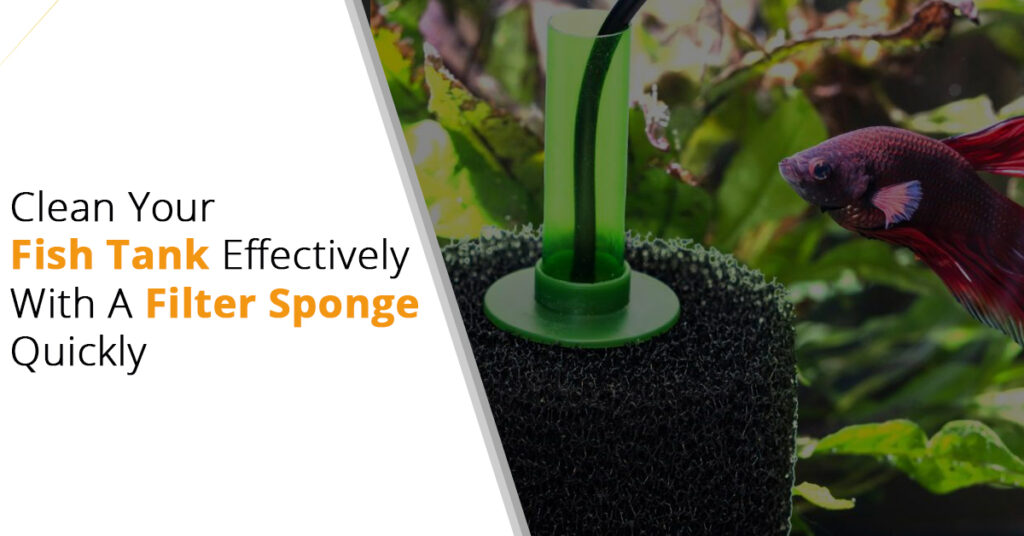People who are new to cleaning fish tanks don’t have any idea about the goodness of sponge filters. But with some time, most people start it as a hobby and later start loving it as a utility tool. Filter sponge cleaners are better than other complex filter types in the market with the right usage. However, some people don’t know how to use them properly. Here we will learn about the proper ways to use them.
Filter sponge units are smaller than bowls or canister fish tank filters and are only a choice for beginners. They are most likely the best options for little tanks like 10 gallons that don’t need much surface agitation and water. They are also ideal for larger tanks with large stocks, either the main or secondary filter unit. The sponge uses foam-like media for clearing water after passing through the system. The flow mostly starts from the air pump, but a powerhead works fine here.
Why Do Users Choose Sponge Filters?
Fish tank filter sponge units are ideal for biochemical filtration but generally have superior biological cleaning capacity. Sometimes, a sponge also traps solid debris more efficiently than mechanical filters. Sponge filters for fish tank units are different sizes and configurations based on the brand designs but have standard functions.
For instance, you get the one in dual-filter sponge arrangement (wall hanging sponge filters) and two back suctions used for attaching it to the tank. Filters with an attachment point quite often fall in the water.
The benefit of the dual-filter sponge configuration compared to the sinking sponge filter style is you can take a sponge from the unit and use it to seed a tank while the second remains in the aquarium.
Another great thing is that it is not present as an indicator. It helps in changing the current direction, which points to the aquarium. It helps slow swimmers such as betta without too much water movement.
Steps To Setting Up The Sponge Filter
Now that you’ve got the idea about the filter sponge, you can think about the sponge filter setup, which is simple, but it is also rational when you can’t set up other filters without much experience.
Here, we’ve got a quick step guide.
We know how to use a filter sponge, but this guide is a proper sponge filter setup. Let’s discuss the steps.
- The first thing you must do is ensure you’ve got everything you want. Counter-check that you’ve got an airline tubing, a sponge filter, and an air pump for the aquarium size. Also, check the airstone and valve (when you’re using one).
- Now, check that the filter sponge is available with all the parts. Ideally, you can also identify the lift tube, foam sponges, and the weight suction points for wall hang sponge filters. Inside the filter sponge, you should also ensure that you’ve got a stainer and top it with a bullseye.
- You should attach the airline to the nipple on the top part of the life tube for the setup. You will notice a small plastic stalk above the nipple, which means that the tubing first goes through it, and you should put it back to its place after the airline goes well in place.
- Also, there isn’t much variation between setting up a filter sponge with an airstone and separately putting it together. The two following steps are vital when adding the unit to the air stone, ideal for creating small bubbles and keeping the filter quiet.
- Some sponge filters also have an additional nipple at the top plate bottom of the lift tube that you can plug in an airline to put airstone towards the bottom.
- When a filter sponge doesn’t have another nipple, but you wish to add an airstone, you should run an air tube through small holes beside the nipple and run an airline to the base.
- After that, the only thing you would have to do before linking the filter to the air source is to install the check valve. It is vital to prevent backflow when the air pump is below the tank surface. Ensure that you add a check valve with an air system on the side from where the air passes by.
Our Related Blogs:- How Does Sponge Filter Work To Remove Impurities From The Aquarium?
Many people want to put a valve by the tank rim. In this way, it doesn’t push extra water over, but also you can put it along with the tank back either close or further from the air pump.
You might not have too much airstone space for double filter sponge style, but you’ll also have nipples along the plastic tube or center column going to the top while plugging the airline.
We further summarize the above steps in short points:
Step 1: Make sure you’ve got the right components. It includes a lift tube, airline, check valve, and sponge filter for the fish tank. Some people select an airstone.
Step 2: For the setup, link the airline to the nipple on the top lift tube part
Step 3: While using the air stone, attach the airline to the second nipple at the top plate lift tube bottom and plug in the air stone to the airline.
Step 4: Now, install the check valve. Install an air pump on the side where the air passes by. The best place for checking the valve is by the tank rim.
Step 5: Plug the filter into the air pump and ensure that the air pump pumps air through a filter sponge with water.
Some Benefits Of Fish Tank Sponge Filter
Sponge filters have various benefits making them a great purchase. They are quite affordable and don’t make any water movement. It is good for slow and dry swimmers such as angelfish or betta.
They have various benefits making them the most used sponges for fish tank cleaning. Here are some benefits of filter sponge units:
Cheap
Filter sponge units are great aquarium filter kits and are easily accessible. You can get it from the local fish store and other chain stores for prices anywhere from USD 5 to 15.
Compared to canister filters, which cost around 120 USD for the basic Fluval 206, sponge filters are ideal for emergencies, such as setting up in hospital tanks.
Very Simple And Straightforward
It is a simple unit to operate at a very cheap price. It doesn’t have complicated parts like a canister filter, and it is also quite straightforward to set up.
Besides an air pump, the filter media, and the filtration unit, the only other parts are airlines for joining the parts.
Also, it’s very easy to clean.
Creates Less Noise
Keeping a fish tank filter is challenging as the units can run on electric power. However, some are more silent than others, and the filter sponge units are there with a canister system.
They don’t make much humming or cranking sounds and don’t make the waterfall noise related to HOBs. The noise to expect from the filter sponge unit is the air pump humming to power the filter cycle.
Also, note when the pump rests on a stand, it forms resonance with wood, which skews the less desirable side of the fish tanks.
Rest pump on filter sponge or foam piece or put it on the floor if you’ve got carpet. People also place them in large containers to hang in mid-air, cutting contact between stand and pump.
Work Fine With Other Filters
The filter sponge works with other units like canisters as a secondary filter system.
Though the filter sponge units act as the main filter, this is true! The units also partner well with other filters as they are small and don’t take up space. Also, they are not very powerful.
Their care and ease of use make them helpful when you don’t need the main filter.
Best Fish Tank Setups For Sponge Filters
The use of filter sponge units in the fish tanks mostly depends on their type. Here they also fit well in certain setups such as quarantine tanks.
Its use, low water movement, affordability, etc., are the factors to consider. Also, you won’t need to deal with dead fishes as they get sucked into the filter system.
These are the perfect setups for filter sponge units, and some work great with this filter type without much havoc.
- Breeding tanks
- Fry tank
- Betta tank
- New fish tank
- Quarantine tank
- Hospital tank
- Shrimp tank
- Beginner small fish tanks
- Larger tanks as a secondary filter
Final Words
Compared to other filters, the filter sponge units are easily available. You can use them whenever you want to clean the fish tank quickly. You can check out premium quality Sponge Center products to get the best filter sponge units. These are made with environment-friendly materials and clean fish tanks efficiently without wasting maintenance. Besides, you can also choose long-lasting, great sponge products with great quality and prices.

